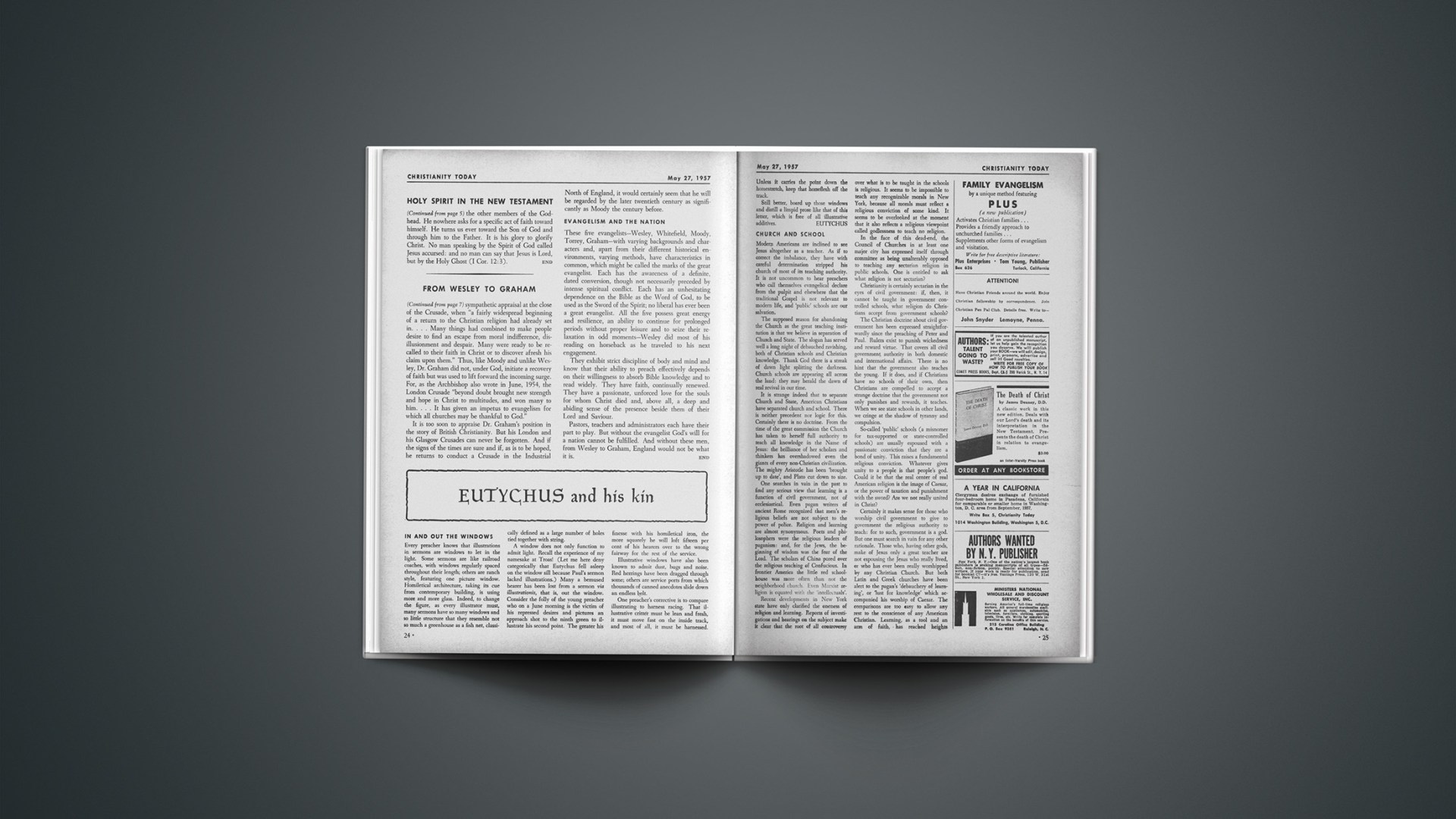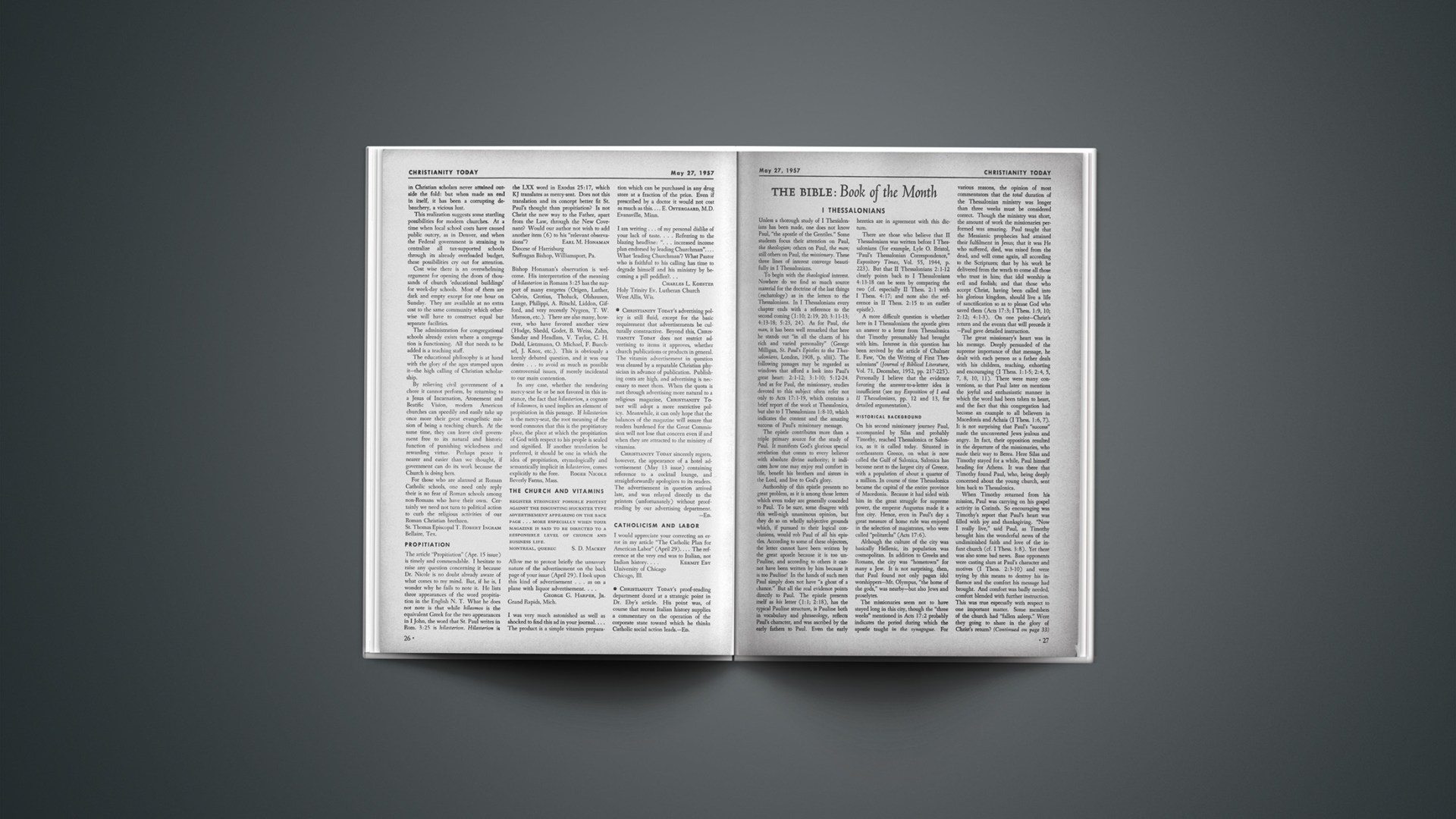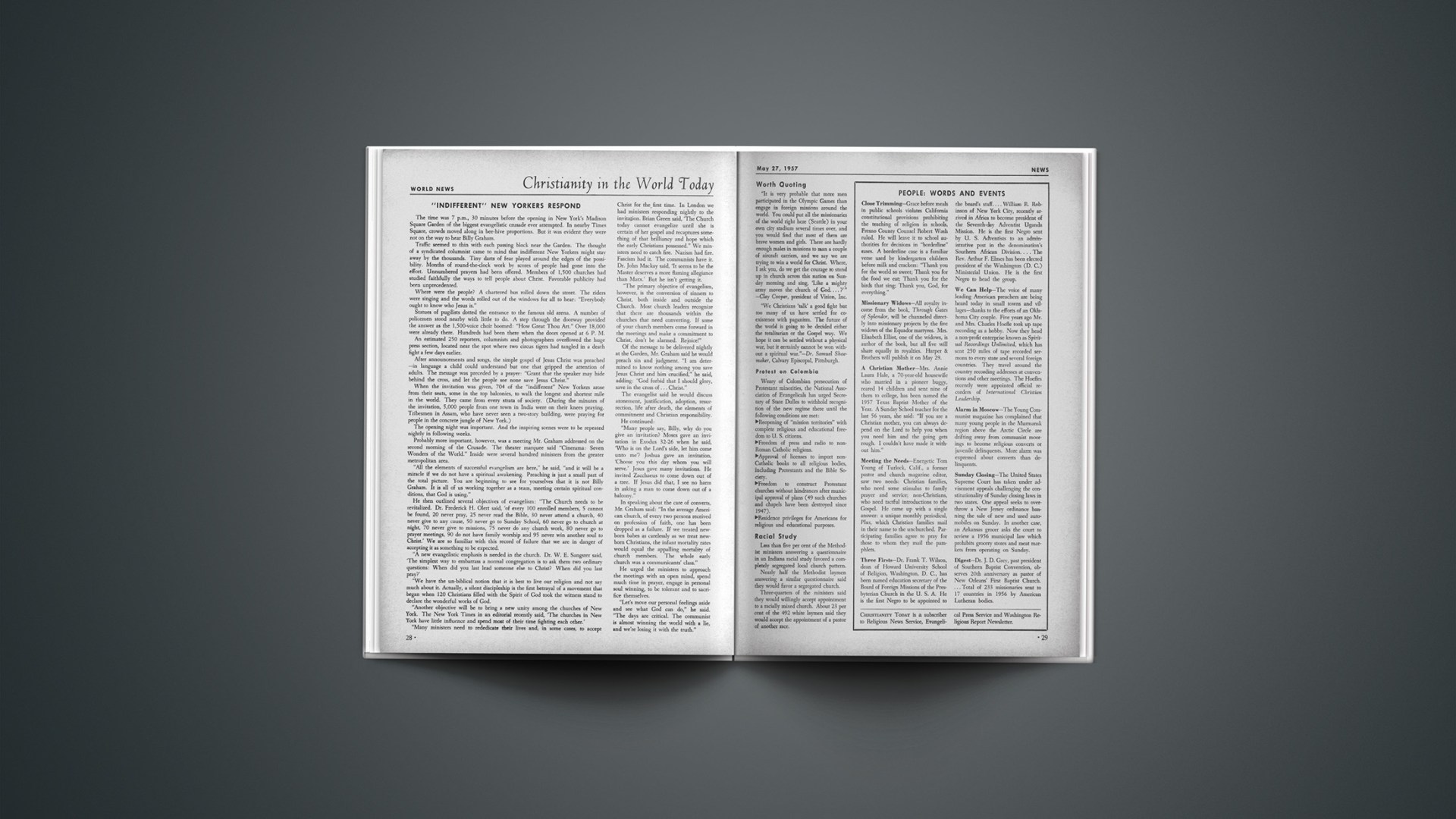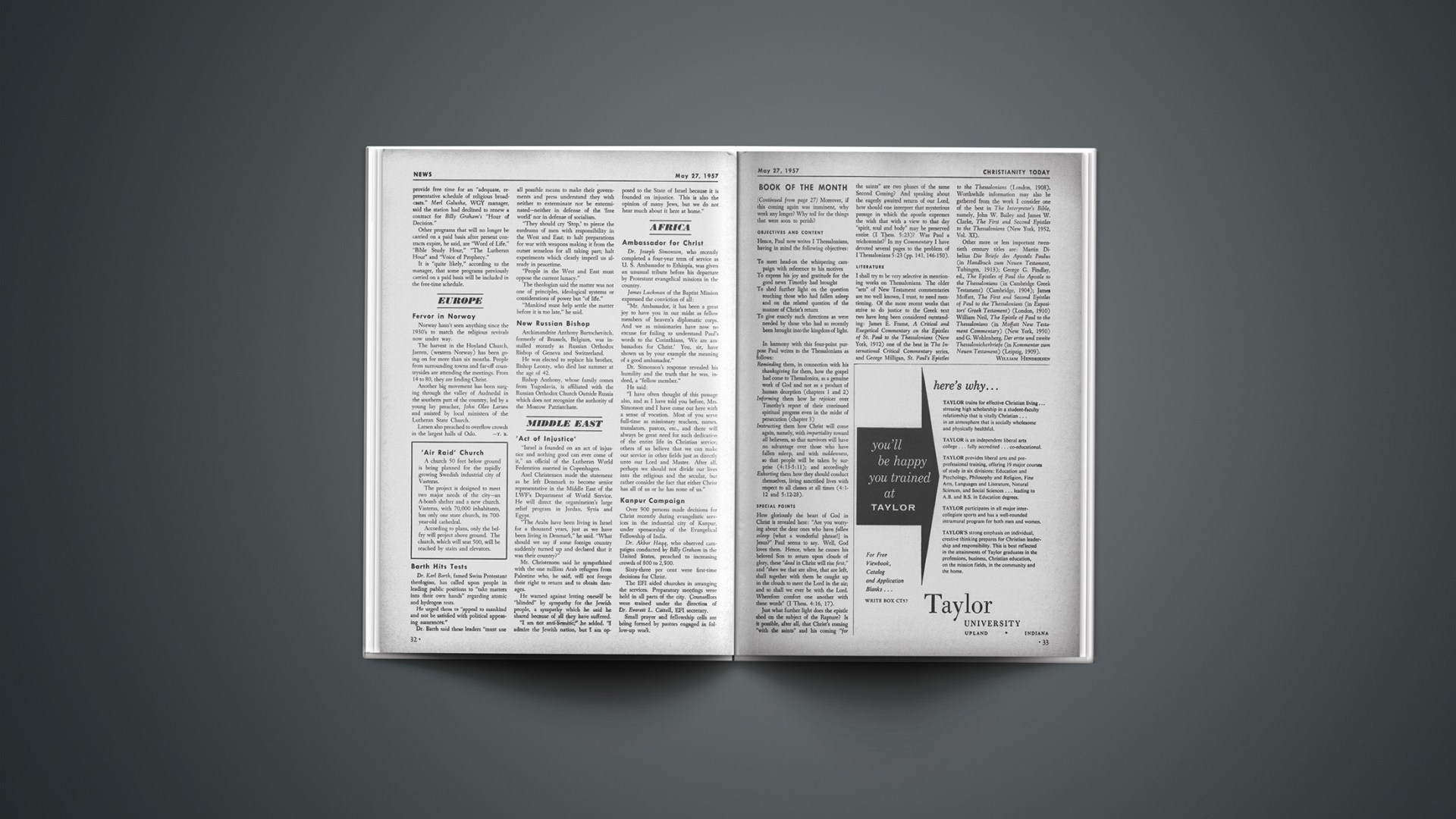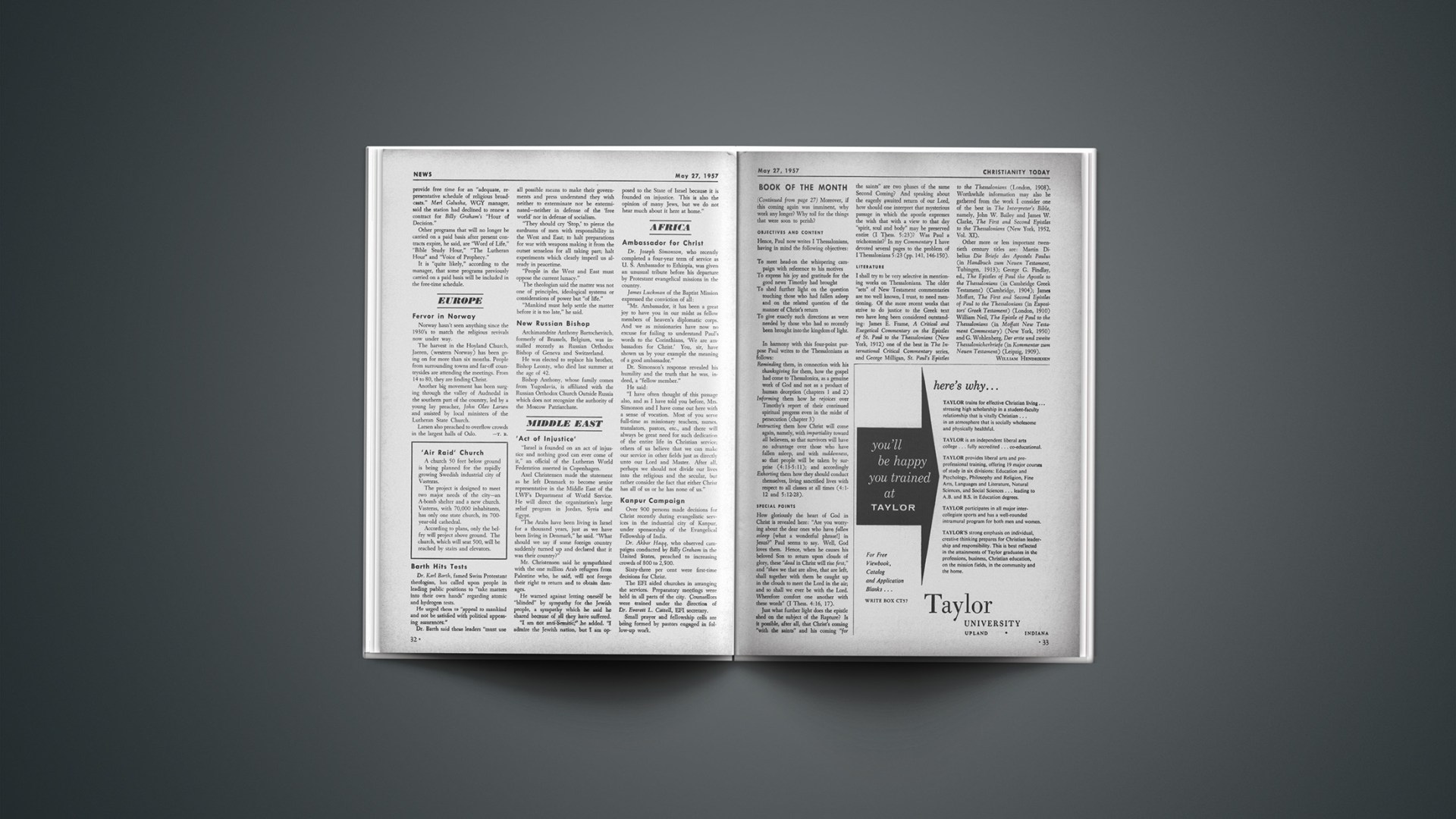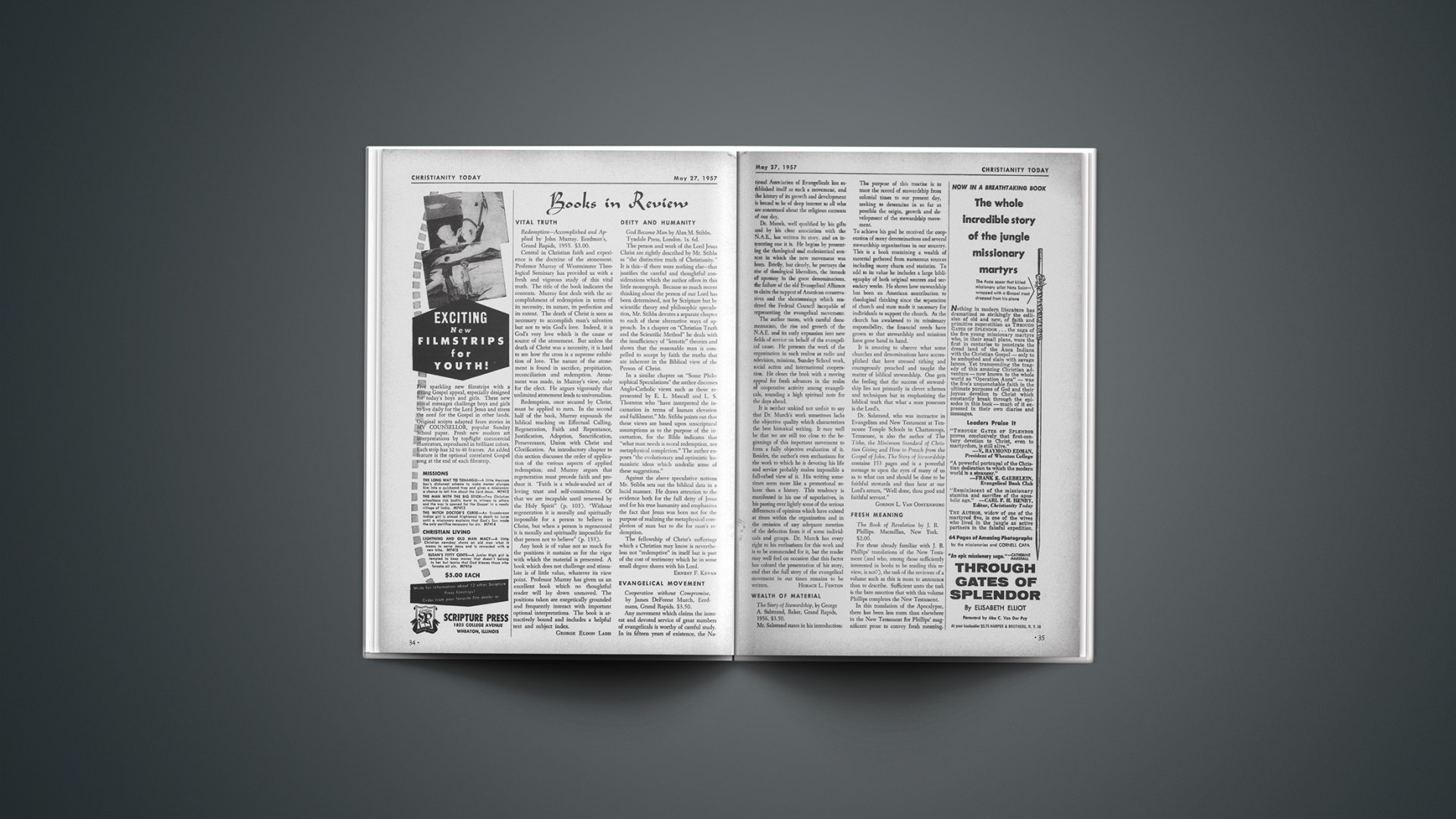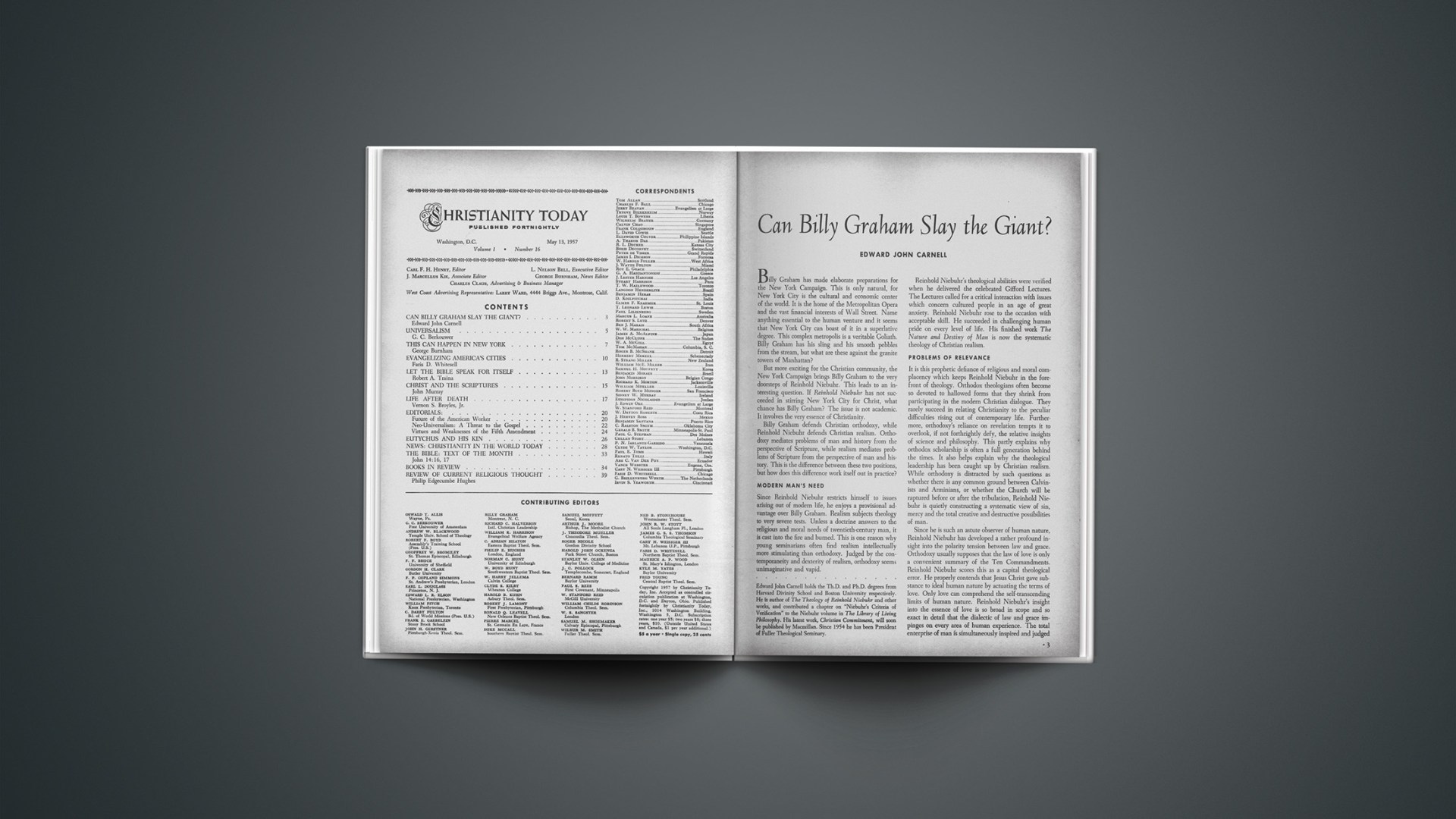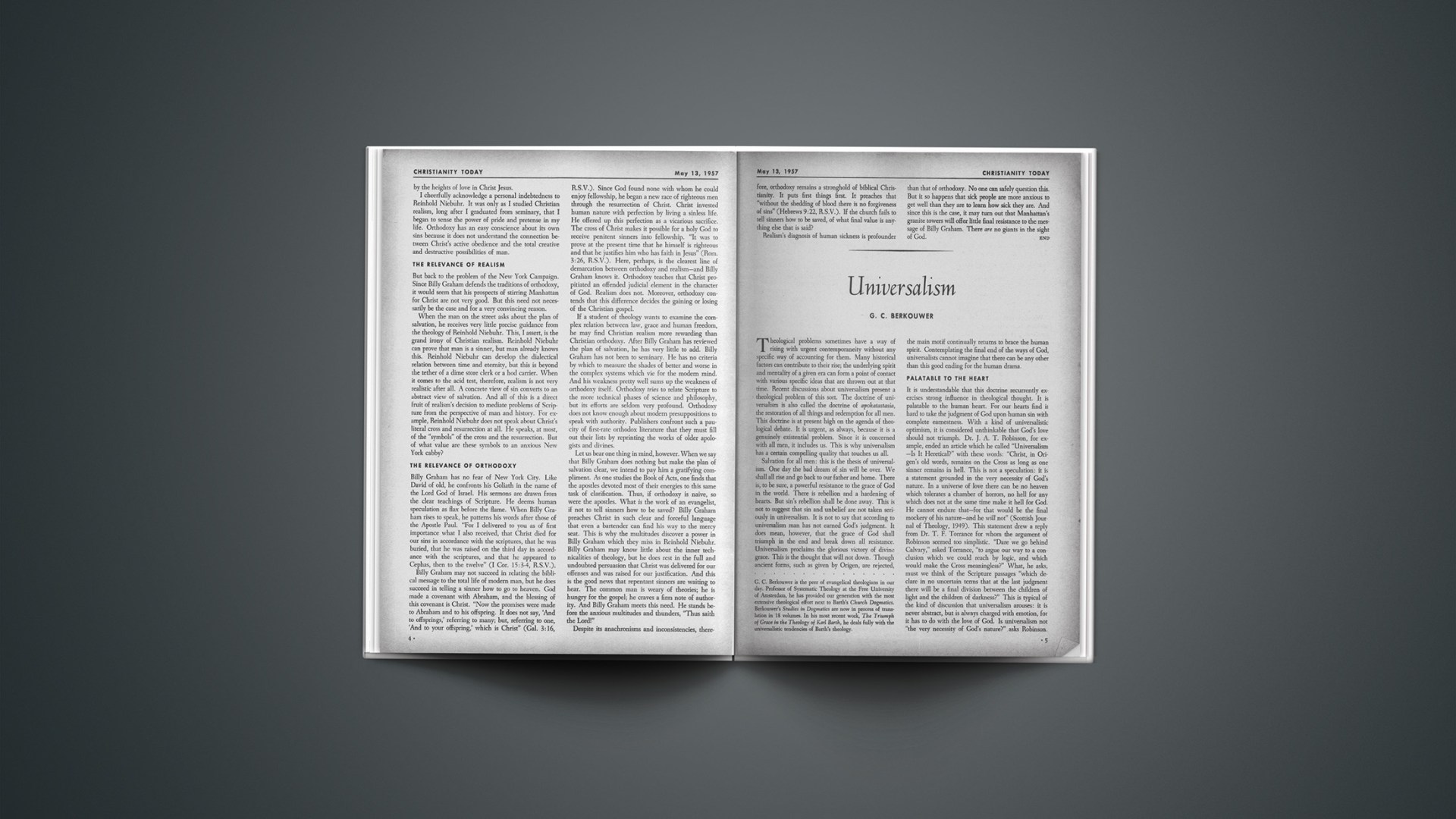IN AND OUT THE WINDOWS
Every preacher knows that illustrations in sermons are windows to let in the light. Some sermons are like railroad coaches, with windows regularly spaced throughout their length; others are ranch style, featuring one picture window. Homiletical architecture, taking its cue from contemporary building, is using more and more glass. Indeed, to change the figure, as every illustrator must, many sermons have so many windows and so little structure that they resemble not so much a greenhouse as a fish net, classically defined as a large number of holes tied together with string.
A window does not only function to admit light. Recall the experience of my namesake at Troas! (Let me here deny categorically that Eutychus fell asleep on the window sill because Paul’s sermon lacked illustrations.) Many a bemused hearer has been lost from a sermon via illustrationis, that is, out the window. Consider the folly of the young preacher who on a June morning is the victim of his repressed desires and pictures an approach shot to the ninth green to illustrate his second point. The greater his finesse with his homiletical iron, the more squarely he will loft fifteen per cent of his hearers over to the wrong fairway for the rest of the service.
Illustrative windows have also been known to admit dust, bugs and noise. Red herrings have been dragged through some; others are service ports from which thousands of canned anecdotes slide down an endless belt.
One preacher’s corrective is to compare illustrating to harness racing. That illustrative critter must be lean and fresh, it must move fast on the inside track, and most of all, it must be harnessed. Unless it carries the point down the homestretch, keep that horseflesh off the track.
Still better, board up those windows and distill a limpid prose like that of this letter, which is free of all illustrative additives.
EUTYCHUS
CHURCH AND SCHOOL
Modern Americans are inclined to see Jesus altogether as a teacher. As if to correct the imbalance, they have with careful determination stripped his church of most of its teaching authority. It is not uncommon to hear preachers who call themselves evangelical declare from the pulpit and elsewhere that the traditional Gospel is not relevant to modern life, and ‘public’ schools are our salvation.
The supposed reason for abandoning the Church as the great teaching institution is that we believe in separation of Church and State. The slogan has served well a long night of debauched ravishing, both of Christian schools and Christian knowledge. Thank God there is a streak of dawn light splitting the darkness. Church schools are appearing all across the land: they may herald the dawn of real revival in our time.
It is strange indeed that to separate Church and State, American Christians have separated church and school. There is neither precedent nor logic for this. Certainly there is no doctrine. From the time of the great commission the Church has taken to herself full authority to teach all knowledge in the Name of Jesus: the brilliance of her scholars and thinkers has overshadowed even the giants of every non-Christian civilization. The mighty Aristotle has been ‘brought up to date’, and Plato cut down to size.
One searches in vain in the past to find any serious view that learning is a function of civil government, not of ecclesiastical. Even pagan writers of ancient Rome recognized that men’s religious beliefs are not subject to the power of police. Religion and learning are almost synonymous. Poets and philosophers were the religious leaders of paganism: and, for the Jews, the beginning of wisdom was the fear of the Lord. The scholars of China pored over the religious teaching of Confucious. In frontier America the little red school-house was more often than not the neighborhood church. Even Marxist religion is equated with the ‘intellectuals’.
Recent developments in New York state have only clarified the oneness of religion and learning. Reports of investigations and hearings on the subject make it clear that the root of all controversy over what is to be taught in the schools is religious. It seems to be impossible to teach any recognizable morals in New York, because all morals must reflect a religious conviction of some kind. It seems to be overlooked at the moment that it also reflects a religious viewpoint called godlessness to teach no religion.
In the face of this dead-end, the Council of Churches in at least one major city has expressed itself through committee as being unalterably opposed to teaching any sectarian religion in public schools. One is entitled to ask what religion is not sectarian?
Christianity is certainly sectarian in the eyes of civil government: if, then, it cannot be taught in government controlled schools, what religion do Christians accept from government schools?
The Christian doctrine about civil government has been expressed straightforwardly since the preaching of Peter and Paul. Rulers exist to punish wickedness and reward virtue. That covers all civil government authority in both domestic and international affairs. There is no hint that the government also teaches the young. If it does, and if Christians have no schools of their own, then Christians are compelled to accept a strange doctrine that the government not only punishes and rewards, it teaches. When we see state schools in other lands, we cringe at the shadow of tyranny and compulsion.
So-called ‘public’ schools (a misnomer for tax-supported or state-controlled schools) are usually espoused with a passionate conviction that they are a bond of unity. This raises a fundamental religious conviction. Whatever gives unity to a people is that people’s god. Could it be that the real center of real American religion is the image of Caesar, or the power of taxation and punishment with the sword? Are we not really united in Christ?
Certainly it makes sense for those who worship civil government to give to government the religious authority to teach: for to such, government is a god. But one must search in vain for any other rationale. Those who, having other gods, make of Jesus only a great teacher are not espousing the Jesus who really lived, or who has ever been really worshipped by any Christian Church. But both Latin and Greek churches have been alert to the pagan’s ‘debauchery of learning’, or ‘lust for knowledge’ which accompanied his worship of Caesar. The comparisons are too easy to allow any rest to the conscience of any American Christian. Learning, as a tool and an arm of faith, has reached heights in Christian scholars never attained outside the fold: but when made an end in itself, it has been a corrupting debauchery, a vicious lust.
This realization suggests some startling possibilities for modern churches. At a time when local school costs have caused public outcry, as in Denver, and when the Federal government is straining to centralize all tax-supported schools through its already overloaded budget, these possibilities cry out for attention.
Cost wise there is an overwhelming argument for opening the doors of thousands of church ‘educational buildings’ for week-day schools. Most of them are dark and empty except for one hour on Sunday. They are available at no extra cost to the same community which otherwise will have to construct equal but separate facilities.
The administration for congregational schools already exists where a congregation is functioning. All that needs to be added is a teaching staff.
The educational philosophy is at hand with the glory of the ages stamped upon it—the high calling of Christian scholarship.
By relieving civil government of a chore it cannot perform, by returning to a Jesus of Incarnation, Atonement and Beatific Vision, modern American churches can speedily and easily take up once more their great evangelistic mission of being a teaching church. At the same time, they can leave civil government free to its natural and historic function of punishing wickedness and rewarding virtue. Perhaps peace is nearer and easier than we thought, if government can do its work because the Church is doing hers.
For those who are alarmed at Roman Catholic schools, one need only reply their is no fear of Roman schools among non-Romans who have their own. Certainly we need not turn to political action to curb the religious activities of our Roman Christian brethren.
T. ROBERT INGRAM
St. Thomas Episcopal
Bellaire, Tex.
PROPITIATION
The article “Propitiation” (Apr. 15 issue) is timely and commendable. I hesitate to raise any question concerning it because Dr. Nicole is no doubt already aware of what comes to my mind. But, if he is, I wonder why he fails to note it. He lists three appearances of the word propitiation in the English N. T. What he does not note is that while hilasmos is the equivalent Greek for the two appearances in I John, the word that St. Paul writes in Rom. 3:25 is hilasterion. Hilasterion is the LXX word in Exodus 25:17, which KJ translates as mercy-seat. Does not this translation and its concept better fit St. Paul’s thought than propitiation? Is not Christ the new way to the Father, apart from the Law, through the New Covenant? Would our author not wish to add another item (6) to his “relevant observations”?
EARL M. HONAMAN
Diocese of Harrisburg
Suffragan Bishop, Williamsport, Pa.
Bishop Honaman’s observation is welcome. His interpretation of the meaning of hilasterion in Romans 3:25 has the support of many exegetes (Origen, Luther, Calvin, Grotius, Tholuck, Olshausen, Lange, Philippi, A. Ritschl, Liddon, Gifford, and very recently Nygren, T. W. Manson, etc.). There are also many, however, who have favored another view (Hodge, Shedd, Godet, B. Weiss, Zahn, Sanday and Headlam, V. Taylor, C. H. Dodd, Lietzmann, O. Michael, F. Buechsel, J. Knox, etc.). This is obviously a keenly debated question, and it was our desire … to avoid as much as possible controversial issues, if merely incidental to our main contention.
In any case, whether the rendering mercy-seat be or be not favored in this instance, the fact that hilasterion, a cognate of hilasmos, is used implies an element of propitiation in this passage. If hilasterion is the mercy-seat, the root meaning of the word connotes that this is the propitiatory place, the place at which the propitiation of God with respect to his people is sealed and signified. If another translation be preferred, it should be one in which the idea of propitiation, etymologically and semantically implicit in hilasterion, comes explicitly to the fore.
ROGER NICOLE
Beverly Farms, Mass.
THE CHURCH AND VITAMINS
REGISTER STRONGEST POSSIBLE PROTEST AGAINST THE DISGUSTING HUCKSTER TYPE ADVERTISEMENT APPEARING ON THE BACK PAGE … MORE ESPECIALLY WHEN YOUR MAGAZINE IS SAID TO BE DIRECTED TO A RESPONSIBLE LEVEL OF CHURCH AND BUSINESS LIFE.
S. D. MACKEY
MONTREAL, QUEBEC
Allow me to protest briefly the unsavory nature of the advertisement on the back page of your issue (April 29). I look upon this kind of advertisement … as on a plane with liquor advertisement.…
GEORGE G. HARPER, JR.
Grand Rapids, Mich.
I was very much astonished as well as shocked to find this ad in your journal.… The product is a simple vitamin preparation which can be purchased in any drug store at a fraction of the price. Even if prescribed by a doctor it would not cost as much as this.…
E. OSTBRGAARD, M.D.
Evansville, Minn.
I am writing … of my personal dislike of your lack of taste.… Referring to the blazing headline: “… increased income plan endorsed by leading Churchman”.… What ‘leading Churchman’? What Pastor who is faithful to his calling has time to degrade himself and his ministry by becoming a pill peddler?…
CHARLES L. KOESTER
Holy Trinity Ev. Lutheran Church
West Allis, Wis.
CHRISTIANITY TODAY’S advertising policy is still fluid, except for the basic requirement that advertisements be culturally constructive. Beyond this, CHRISTIANITY TODAY does not restrict advertising to items it approves, whether church publications or products in general. The vitamin advertisement in question was cleared by a reputable Christian physician in advance of publication. Publishing costs are high, and advertising is necessary to meet them. When the quota is met through advertising more natural to a religious magazine, CHRISTIANITY TODAY will adopt a more restrictive policy. Meanwhile, it can only hope that the balances of the magazine will assure that readers burdened for the Great Commission will not lose that concern even if and when they are attracted to the ministry of vitamins.
CHRISTIANITY TODAY sincerely regrets, however, the appearance of a hotel advertisement (May 13 issue) containing reference to a cocktail lounge, and straightforwardly apologizes to its readers. The advertisement in question arrived late, and was relayed directly to the printers (unfortunately) without proof-reading by our advertising department.
—ED.
CATHOLICISM AND LABOR
I would appreciate your correcting an error in my article “The Catholic Plan for American Labor” (April 29).… The reference at the very end was to Italian, not Indian history.…
KERMIT EBY
University of Chicago
Chicago, Ill.
CHRISTIANITY TODAY’S proof-reading department dozed at a strategic point in Dr. Eby’s article. His point was, of course that recent Italian history supplies a commentary on the operation of the corporate state toward which he thinks Catholic social action leads.—ED.

